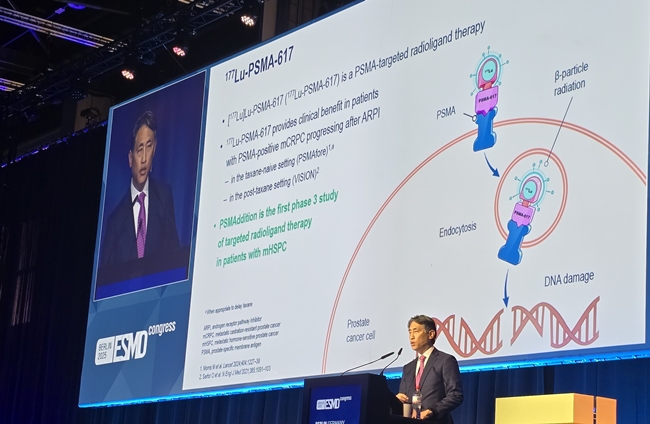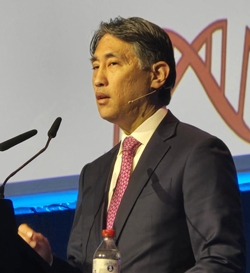- Pluvicto demonstrates first-line efficacy in prostate cancer
- by Hwang, byoung woo | translator Alice Kang | Oct 21, 2025 06:19am
This is considered the first Phase III evidence confirming Pluvicto's potential to extend beyond existing castration-resistant prostate cancer (mCRPC) into the first-line (mHSPC) setting.

The findings from the Phase III PSMAddition trial, presented on October 19 at the ESMO 2025 Congress by Professor Scott T. Tagawa of Weill Cornell Medicine (U.S.), confirm the potential for Pluvicto to move earlier in the prostate cancer treatment paradigm.
This study enrolled 1,144 patients with PSMA-positive mHSPC who were either treatment-naive (≤45 days) or had received minimal prior therapy.
Patients were randomized 1:1 to either the combination group (572 patients) receiving Pluvicto + androgen deprivation therapy (ADT) + ARPI, or the ADT + ARPI monotherapy group (572 patients).
Pluvicto was administered at 7.4 GBq every 6 weeks for up to six cycles, with stratification by disease volume (high vs low), age (≥ 70 years), and prior local treatment history of the primary tumor.
The primary endpoint was radiographic progression-free survival (rPFS), with secondary endpoints including overall survival (OS), objective response rate (ORR), safety, and quality of life (QoL).
At a median follow-up of 23.6 months, neither group had reached median rPFS, but the Pluvicto combination group showed a 28% lower risk of disease progression or death. Overall survival (OS) also had not reached its median, but showed an improvement trend in the Pluvicto group.
The objective response rate (ORR) was 85.3% vs 80.8%, and rPFS improvement was consistent across all predefined subgroups.
Safety profile consistent with existing data… No impact on quality of life
Treatment-emergent adverse events (TEAEs) were reported in 98.4% vs 96.6% of patients, with grade ≥ 3 events occurring in 50.7% vs 43.0%, respectively.
The most common AEs were dry mouth (46.5%), fatigue, and nausea, which were mostly mild (Grade 1–2).
Hematologic toxicities (anemia, neutropenia, thrombocytopenia) were more frequent in the combination group but were generally manageable. There were no significant differences between groups in quality of life measures (Fact-P, BPI-SF, etc.).

He further emphasized, “These results provide evidence that an early combination strategy with Pluvicto may offer clinical benefit.”
Professor Ana C. Garrido-Castro (Dana-Farber Cancer Institute/Harvard Medical School), who served as a discussant in the same session, noted, “PSMAddition is the first large-scale Phase III trial demonstrating that PSMA-targeted radiotherapeutics achieve meaningful efficacy even in the hormone-sensitive stage.”
PSMAddition demonstrated that Pluvicto has emerged as a candidate for a new standard of care as a combination therapy in the early stages of prostate cancer using radioligand therapy (RLT). These findings are expected to serve as key evidence supporting future label expansion into the hormone-sensitive setting.
-

- 0
댓글 운영방식은
댓글은 실명게재와 익명게재 방식이 있으며, 실명은 이름과 아이디가 노출됩니다. 익명은 필명으로 등록 가능하며, 대댓글은 익명으로 등록 가능합니다.
댓글 노출방식은
댓글 명예자문위원(팜-코니언-필기모양 아이콘)으로 위촉된 데일리팜 회원의 댓글은 ‘게시판형 보기’와 ’펼쳐보기형’ 리스트에서 항상 최상단에 노출됩니다. 새로운 댓글을 올리는 일반회원은 ‘게시판형’과 ‘펼쳐보기형’ 모두 팜코니언 회원이 쓴 댓글의 하단에 실시간 노출됩니다.
댓글의 삭제 기준은
다음의 경우 사전 통보없이 삭제하고 아이디 이용정지 또는 영구 가입제한이 될 수도 있습니다.
-
저작권·인격권 등 타인의 권리를 침해하는 경우
상용 프로그램의 등록과 게재, 배포를 안내하는 게시물
타인 또는 제3자의 저작권 및 기타 권리를 침해한 내용을 담은 게시물
-
근거 없는 비방·명예를 훼손하는 게시물
특정 이용자 및 개인에 대한 인신 공격적인 내용의 글 및 직접적인 욕설이 사용된 경우
특정 지역 및 종교간의 감정대립을 조장하는 내용
사실 확인이 안된 소문을 유포 시키는 경우
욕설과 비어, 속어를 담은 내용
정당법 및 공직선거법, 관계 법령에 저촉되는 경우(선관위 요청 시 즉시 삭제)
특정 지역이나 단체를 비하하는 경우
특정인의 명예를 훼손하여 해당인이 삭제를 요청하는 경우
특정인의 개인정보(주민등록번호, 전화, 상세주소 등)를 무단으로 게시하는 경우
타인의 ID 혹은 닉네임을 도용하는 경우
-
게시판 특성상 제한되는 내용
서비스 주제와 맞지 않는 내용의 글을 게재한 경우
동일 내용의 연속 게재 및 여러 기사에 중복 게재한 경우
부분적으로 변경하여 반복 게재하는 경우도 포함
제목과 관련 없는 내용의 게시물, 제목과 본문이 무관한 경우
돈벌기 및 직·간접 상업적 목적의 내용이 포함된 게시물
게시물 읽기 유도 등을 위해 내용과 무관한 제목을 사용한 경우
-
수사기관 등의 공식적인 요청이 있는 경우
-
기타사항
각 서비스의 필요성에 따라 미리 공지한 경우
기타 법률에 저촉되는 정보 게재를 목적으로 할 경우
기타 원만한 운영을 위해 운영자가 필요하다고 판단되는 내용
-
사실 관계 확인 후 삭제
저작권자로부터 허락받지 않은 내용을 무단 게재, 복제, 배포하는 경우
타인의 초상권을 침해하거나 개인정보를 유출하는 경우
당사에 제공한 이용자의 정보가 허위인 경우 (타인의 ID, 비밀번호 도용 등)
※이상의 내용중 일부 사항에 적용될 경우 이용약관 및 관련 법률에 의해 제재를 받으실 수도 있으며, 민·형사상 처벌을 받을 수도 있습니다.
※위에 명시되지 않은 내용이더라도 불법적인 내용으로 판단되거나 데일리팜 서비스에 바람직하지 않다고 판단되는 경우는 선 조치 이후 본 관리 기준을 수정 공시하겠습니다.
※기타 문의 사항은 데일리팜 운영자에게 연락주십시오. 메일 주소는 dailypharm@dailypharm.com입니다.
- [Op-Ed] Patients, no time left for 'new drug comb therapies'
- Special Contribution | Eo, Yun-Ho









